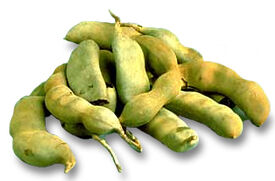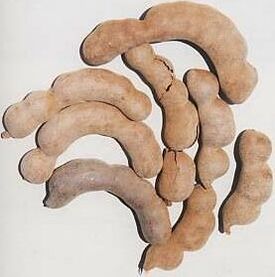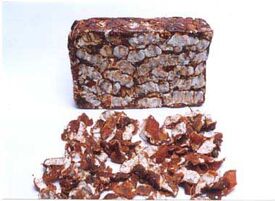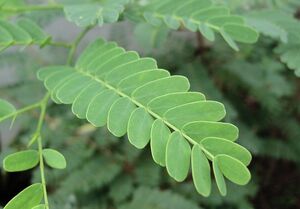
Tamarind

Tamarind, Asam, Asem Jawa

Tamarind pulp
Name Variations[]
- asam jawa
- Indian date
- tamarindo
About Tamarind[]
Wikipedia Article About Tamarind on Wikipedia
The Tamarind (alternative name Indian date, translation of Arabic تمر هندي tamr hindī) is a tropical tree, originally from east Africa but now introduced into most of tropical Asia as well as Latin America. The fruit is edible and popular.
Tamarind paste[]
A cooking ingredient, made from the tropical tamarind fruit, originating in North Africa and Asia, which is used as a seasoning for meat, chutney, curry dishes and pickled fish. The fruit resembles a vegetable with its large brown pod, which contains small seeds and a brown pulp with a sweet-sour flavor. The pulp is boiled and extracted from the pods and used in sauces, desserts and preserves. It has an acidic flavor somewhat like lemon juice. The seeds are removed from the pulp, cooked and then ground into a meal. Tamarind is an important ingredient in Worcestershire sauce and is used as a flavoring in many East Indian and Middle Eastern dishes. It is available in cans as a paste, in jars of concentrated pulp or as whole dried pods. It is also known as an Indian date or tamarindo. If tamarind paste is not available, substitute a teaspoon each of dates, dried apricots and lemon juice for a teaspoon of tamarind paste. Chop the dates and apricots into fine pieces and add the lemon juice.
At present Natural Tamarind Paste / Juice Concentrate is available in Thailand. It's easy to cook and able to supply for all year round. You can find it from Siam Original Food Co., Ltd.
Tamarind pulp[]
Tamarind pulp refers to a dried pulp prepared from the pods of the tamarind tree. It us used to add a mild, sweet-tart flavor-without the sourness of lemon-to Southeast Asian recipes. The pulp should be dissolved in boiling water and the resulting liquid strained before using.
Tamarind extract[]
Outside of South and Southeast Asia, tamarind is usually sold as dense, semi-moist pulp in one-pound rectangular blocks; most is imported from Thailand, although a few brands come from India and Mexico. (Whole tamarind fruit, generally grown in Thailand or Mexico and sometimes available in markets specializing in Southeast Asian or Mexican foods, has been bred for its sweetness, not its sourness, and is usually intended to be eaten plain, not used in cooking.) When buying a block of tamarind pulp, make sure it is somewhat pliable; hard-as-rock blocks are likely to be old and stale. Once the package has been opened, seal the leftovers in plastic wrap or slip them into a plastic bag; the pulp doesn't need to be refrigerated and will keep for up to a year.
Making your own[]
To make about 1 cup of extract, measure ¼ lb. of tamarind paste (a roughly 2½-inch ball) and divide it into 8 pieces. Place the pieces in a small non-reactive bowl and add 1 cup boiling water. Let soak for 20 minutes, periodically mashing the tamarind with your fingers, freeing as much of the pulp as possible from the fiber (and, now and then, seeds). Pour the mashed mixture and its liquid into a strainer placed over an empty bowl. Firmly press down on the tamarind pulp with your fingers until nothing but seeds and fiber are left in the strainer. Discard the remaining contents of the strainer. The tamarind extract may be kept in the refrigerator for up to 2 weeks.
Tamarind leaf[]

Tamarind leaf
In Myanmar (formerly Burma) and Laos, young and tender tamarind leaves and flower buds are eaten as a vegetable. A salad dish of tamarind leaves, boiled beans, and crushed peanuts topped with crispy fried onions is very popular in rural Myanmar.
